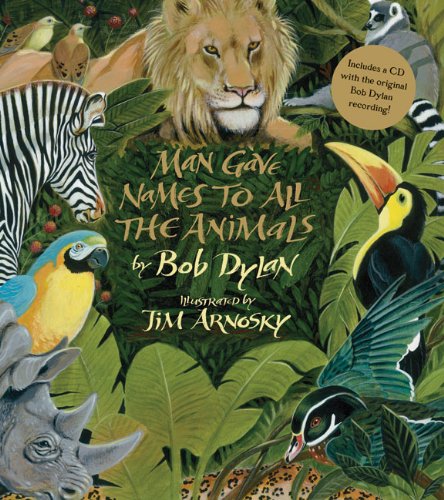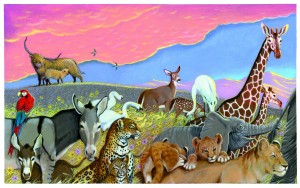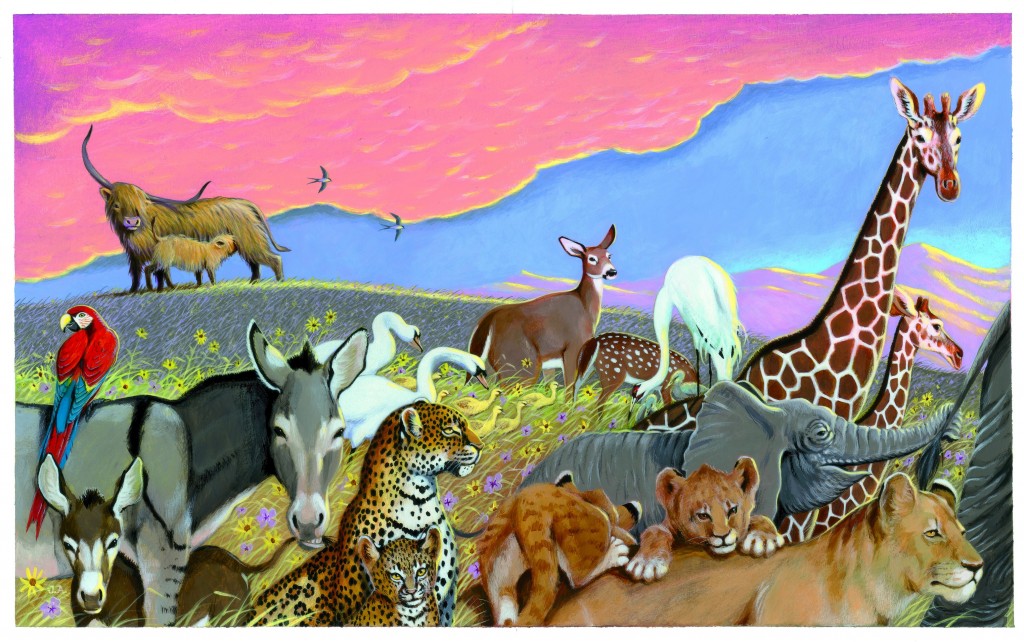By Phoebe Vreeland, The Children’s Book Review
Published: September 16, 2010
 MAN GAVE NAMES TO ALL THE ANIMALS
MAN GAVE NAMES TO ALL THE ANIMALS
By Bob Dylan (Author), Jim Arnosky (Illustrator)
Reading level: Ages 4-8
Hardcover: 32 pages
Publisher: Sterling; Har/Com edition (September 7, 2010)
Source: Publisher
I had been trying to introduce Bob Dylan to my four-year-old daughter with entirely the wrong song. Clearly, dancing around the house together to Dylan’s “Everything is Broken” was a crazy idea. Recently, Bianca Schulze handed me the new children’s book Man Gave Names To All The Animals—a beautifully illustrated picture book by Jim Arnosky with Bob Dylan’s lyrics as text. The book includes a CD of the original recording with its jumpy island beat and soft female background vocals. With the right groove and stunning pictures, a new Dylan fan is born.
Few adult Dylan fans rave about this song from the 1979 release Slow Train Coming, but the song actually lends itself well to a sing-a-long with its simple chorus and predictable rhymes. While repetitive, it won’t become an annoying ear bug like so many kids songs can. Those new to the song may appreciate the book’s text since Dylan’s signature gruff, nasal vocals are at times hard to understand. It’s a playful song and children will delight while calling out the animals’ names.
However, the true reason why I am happy to have discovered this book is it brought Jim Arnosky to my awareness. As a mother of a four-year old daughter I read a lot about pink princesses and cuddly creatures. It’s refreshing to have discovered someone who is passionately committed to connecting children with the natural world. Arnosky has written and/or illustrated over a hundred books about nature—books with titles like Slither and Crawl, Crocodile Safari, and Every Autumn Comes the Bear.
Using nature as the underlying theme, his books are as varied as they are plentiful and appropriately adapted to all ages. He has reached the very youngest with his “Mouse” series of picture books and the adorable Rabbits and Raindrops and Otters Underwater. Arnosky writes books for the older child that draw him out into the natural world while engaging in it—teaching outdoor skills, identification, sketching or merely observing—inviting them to “see as an artist would and observe as a naturalist would.” He has been praised for not romanticizing or humanizing animals. Influenced by the great nature writers John Burroughs and Ernest Thomas Seaton, Arnosky has said that their writings enticed him out into the natural world and he hopes his books will do the same for others.
Living and working in a rural Vermont where his family life and vocation join seamlessly, he sets a beautiful example of how one can blend their passion and their livelihood. Arnosky has said, “The life I lead is a reward in itself.” What a positive example of following one’s bliss.
So … while we parents try to steal the time to finish reading Last Child in the Woods, let’s introduce our children to Arnosky’s books. I have faith that his latest book will re-introduce Dylan’s song as a classic children’s sing-a-long. Yes, it has been done before— there is an earlier book of the same title illustrated by Scott Menchin that is now out of print—however, Arnosky seems to have had a higher vision and it shows in the book.
Man Gave Names to All the Animals opens with Arnosky’s inspiration for illustrating the Dylan song:
“From the first time I heard it, the lyrics created pictures in my mind of a land of primeval beauty, where the sky and earth were new and the animals knew no fear. I thought this vision would make a dream of a book.”
 And, a dream it is! By painting over a dozen animal scenes in a variety of landscapes, he has achieved that primeval feel. The pages are filled with wild plants: bromeliads and strangler figs, lush palms—and distant volcanoes. By varying the time of day—the skies are blue, then pink, then starry indigo—he achieves a timeless quality. A huge variety of animals are gathered together in a rich parade: monkeys grab tails, exotic birds perch on the heads and backs of larger beasts in a peaceful menagerie. Arnosky is adept at wildlife painting and each animal is given a worthy portraiture. I am amazed at how, with a slight brushstroke of white, Arnosky brings such life to their eyes.
And, a dream it is! By painting over a dozen animal scenes in a variety of landscapes, he has achieved that primeval feel. The pages are filled with wild plants: bromeliads and strangler figs, lush palms—and distant volcanoes. By varying the time of day—the skies are blue, then pink, then starry indigo—he achieves a timeless quality. A huge variety of animals are gathered together in a rich parade: monkeys grab tails, exotic birds perch on the heads and backs of larger beasts in a peaceful menagerie. Arnosky is adept at wildlife painting and each animal is given a worthy portraiture. I am amazed at how, with a slight brushstroke of white, Arnosky brings such life to their eyes.
While Dylan’s song names common animals that children are familiar with, Arnosky chose to paint a wilder variety of each beast. The Highland cow, wild boar and big horned sheep replace typical farm animals. All the horn, tusk and scraggly hair keep with Arnosky’s vision. In all, over 170 different species appear in the book. Kids can have fun naming all the animals framed in the pages.
There are a few pages of such perfect composition I wished they could be murals in some classroom or museum. I particularly like the nocturnal scene with its deep blue night sky and full moon. A statuesque silhouette of a bull is set behind a line of chimps and a pair of hornbills. In the background a gibbon stares blankly at us as he hangs from a strangler fig. The scene gives me the same feeling I used to get from Maurice Sendak’s classic Where The Wild Things Are.
Those familiar with Dylan’s song know that the very last beast is not named. So, while adults ponder a deeper meaning to those lyrics, our kids can sing joyfully along with Bob. Arnosky’s art has placed a musical icon on our children’s bookshelf.
Published by Sterling, Man Gave Names To All The Animals is a high quality book. Peel the jacket off and you won’t ever fret if it gets torn or lost—the hard cover illustration is a stunner. The CD placement is well though out—almost childproofed into the back book cover. Pick up an extra copy for a gift and while you’re at it add a few of Arnosky’s other treasures to your child’s bookshelf. You will be planting seeds for future naturalists.
Add this book to your collection: Man Gave Names To All The Animals
Art from Man Gave Names to All the Animals, © 2010 by Jim Arnosky, Sterling Children’s Books.

